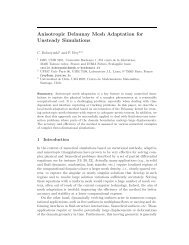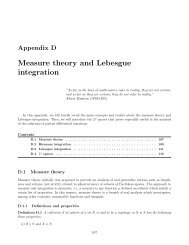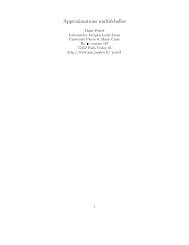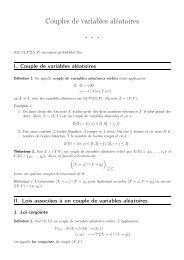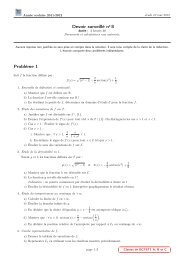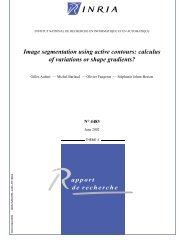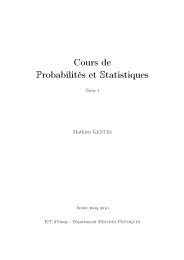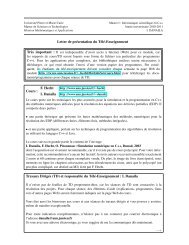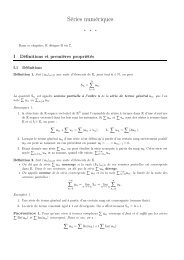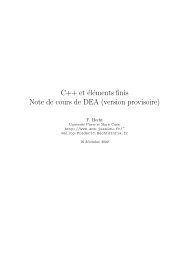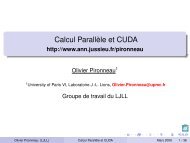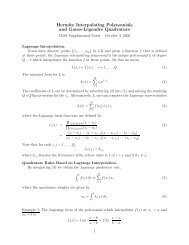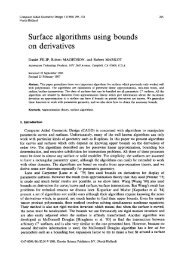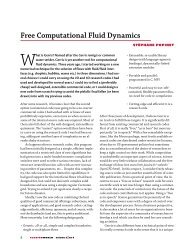pdf file
pdf file
pdf file
You also want an ePaper? Increase the reach of your titles
YUMPU automatically turns print PDFs into web optimized ePapers that Google loves.
12 M. LEWIN, P. T. NAM, S. SERFATY, AND J. P. SOLOVEJ<br />
ground state Ψ (1)<br />
N for N large enough. Furthermore (up to a correct choice<br />
of phase for Ψ (1)<br />
N ),<br />
(1)<br />
lim UNΨ<br />
N→∞<br />
N = Φ(1)<br />
(20)<br />
strongly in F+. The latter convergence is strong in the norm induced by the<br />
quadratic form of H on F+ if (A3s) holds true.<br />
(iv) (Convergence of lower eigenvectors). Assume that λL(H) < infσess(H)<br />
for some L ≥ 1. Then λL(H) is the L-th eigenvalue of H and for N large<br />
enough, λL(HN) is the L-th eigenvalue of HN. Furthermore, if � Ψ (L) �<br />
N N≥2<br />
is a sequence of associated eigenvectors, then, up to a subsequence,<br />
(L)<br />
lim UNΨ<br />
N→∞<br />
N = Φ(L)<br />
(21)<br />
strongly in F+, where Φ (L) is an eigenvector of H associated with the eigenvalue<br />
λL(H). The latter convergence is strong in the norm induced by the<br />
quadratic form of H on F+ if (A3s) holds true.<br />
The proof of Theorem 2 is provided in Section 7.1. Let us now make some<br />
comments on this result.<br />
The weak limit (19) shows how the Bogoliubov Hamiltonian H arises<br />
from the particle-conserving Hamiltonian HN. This convergence essentially<br />
implies the upper bounds on the eigenvalues of HN and this is the easy part<br />
of our proof. In previous results (for instance in [55]) the upper boundswere<br />
more involved because the argument was carried out in the original Fock<br />
space F and the trial state had to be projected on HN . On the contrary<br />
we work in the excited Fock space F+ and only need to project the state<br />
on F ≤M<br />
+ with M ≤ N (in practice 1 ≪ M ≪ N) before applying U∗ N ,<br />
which is much easier. Note that we actually do not need the condensation<br />
assumption (A3) for showing (i) and the upper bound on the eigenvalues.<br />
Thedifficultpartoftheproofisthelower boundon theeigenvalues, which<br />
requires (A3) as well as a localization method in the Fock space F+, in the<br />
spirit of a previous result of Lieb and Solovej [41, Thm. A.1]. The idea is<br />
to estimate the error made by replacing a vector Φ ∈ F+ by its truncation<br />
on F ≤M<br />
+ , in a lower bound. This method is the object of Section 6 where<br />
we prove an IMS-type localization formula.<br />
Even if our simplified statement does not reflect this, we are able to prove<br />
explicit error estimates. For instance, for the convergence of λL(HN) in (ii),<br />
we will prove that<br />
�<br />
−CL εRL (N)+N−1/3� ≤ λL(HN)−NeH −λL(H) ≤ CLN −1/3<br />
(22)<br />
for N large enough, where CL and RL only depend on (λL(H)−λ1(H)) and<br />
(λL(HN)−λ1(HN)), and where we recall that εRL is given in Assumption<br />
(A3). Similar estimates can be obtained for the eigenfunctions. Under the<br />
strong condensation assumption (A3s), our proof shows that one can take<br />
εR(N) = O(N −1 ), leading to an overall error of the order O(N −1/3 ).<br />
In [52, 24], Seiringer and Grech have shown a result similar to Theorem 2.<br />
More precisely, in [52] Seiringer treated the case of Ω a cube in any dimension,<br />
T = −∆ with periodic boundary conditions, and w a bounded and



